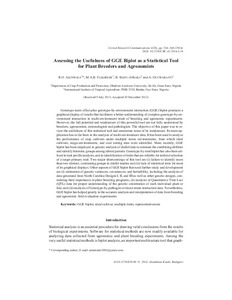| dc.contributor.author | Akinwale, R. |
| dc.contributor.author | Fakorede, M.A.B. |
| dc.contributor.author | Badu-Apraku, B. |
| dc.contributor.author | Oluwaranti, A. |
| dc.date.accessioned | 2019-12-04T11:03:33Z |
| dc.date.available | 2019-12-04T11:03:33Z |
| dc.date.issued | 2014 |
| dc.identifier.citation | Akinwale, R., Fakorede, M., Badu-Apraku, B. & Oluwaranti, A. (2014). Assessing the usefulness of GGE biplot as a statistical tool for plant breeders and agronomists. Cereal Research Communications, 42(3), 534-546.. |
| dc.identifier.issn | 0133-3720 |
| dc.identifier.uri | https://hdl.handle.net/20.500.12478/1137 |
| dc.description | Published Online: Sep 06, 2014 |
| dc.description.abstract | Genotype main effect plus genotype-by-environment interaction (GGE) biplot produces a graphical display of results that facilitates a better understanding of complex genotype-by-environment interaction in multi-environment trials of breeding and agronomic experiments. However, the full potential and weaknesses of this powerful tool are not fully understood by breeders, agronomists, entomologists and pathologists. The objective of this paper was to review the usefulness of this statistical tool and enumerate some of its weaknesses. Its main application has so far been in the analysis of multi-environment data. It has been used to analyze the performance of crop cultivars under multiple stress environments, from which ideal cultivars, mega-environments, and core testing sites were identified. More recently, GGE biplot has been employed in genetic analysis of diallel data to estimate the combining abilities and identify heterotic groups among inbred parents. Genotype-by-trait biplot has also been utilized in trait profile analysis, and in identification of traits that are reliable for indirect selection of a target primary trait. Two major shortcomings of this tool are (i) failure to identify more than two distinct, contrasting groups in diallel studies and (ii) lack of statistical tests for most of its graphical displays. Other aspects of GGE biplot that need further study and development are (i) estimation of genetic variances, covariances, and heritability, including the analysis of data generated from North Carolina Designs I, II, and III as well as other genetic designs, considering their importance in plant breeding programs; (ii) analysis of Quantitative Trait Loci (QTL) data for proper understanding of the genetic constitution of each individual plant or line; and (iii) analysis of Genotype-by-pathogen or insect strain interaction data. Nevertheless, GGE biplot has helped greatly in the accurate analysis and interpretation of data from breeding and agronomic field evaluation experiments. |
| dc.language.iso | en |
| dc.subject | Plant Breeding |
| dc.subject | Environment |
| dc.subject | Genotypes |
| dc.title | Assessing the usefulness of GGE biplot as a statistical tool for plant breeders and agronomists |
| dc.type | Journal Article |
| dc.description.version | Peer Review |
| cg.contributor.affiliation | International Institute of Tropical Agriculture |
| cg.contributor.affiliation | Obafemi Awolowo University |
| cg.coverage.region | Africa |
| cg.coverage.region | West Africa |
| cg.coverage.country | Nigeria |
| cg.isijournal | ISI Journal |
| cg.authorship.types | CGIAR and developing country institute |
| cg.iitasubject | Plant Breeding |
| cg.journal | Cereal Research Communications |
| cg.howpublished | Formally Published |
| cg.accessibilitystatus | Limited Access |
| local.dspaceid | 78135 |
| cg.identifier.doi | https://dx.doi.org/10.1556/CRC.42.2014.3.16 |

